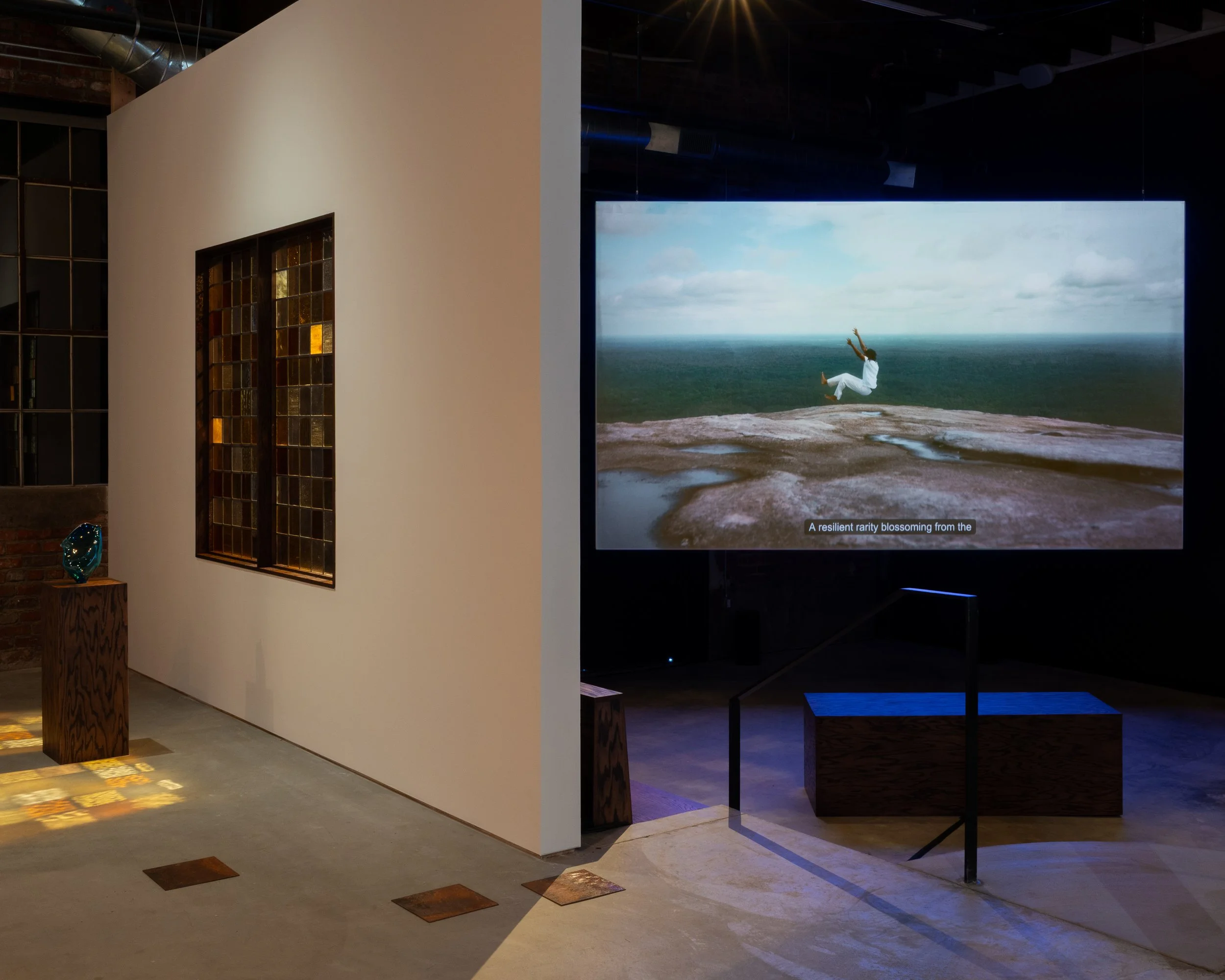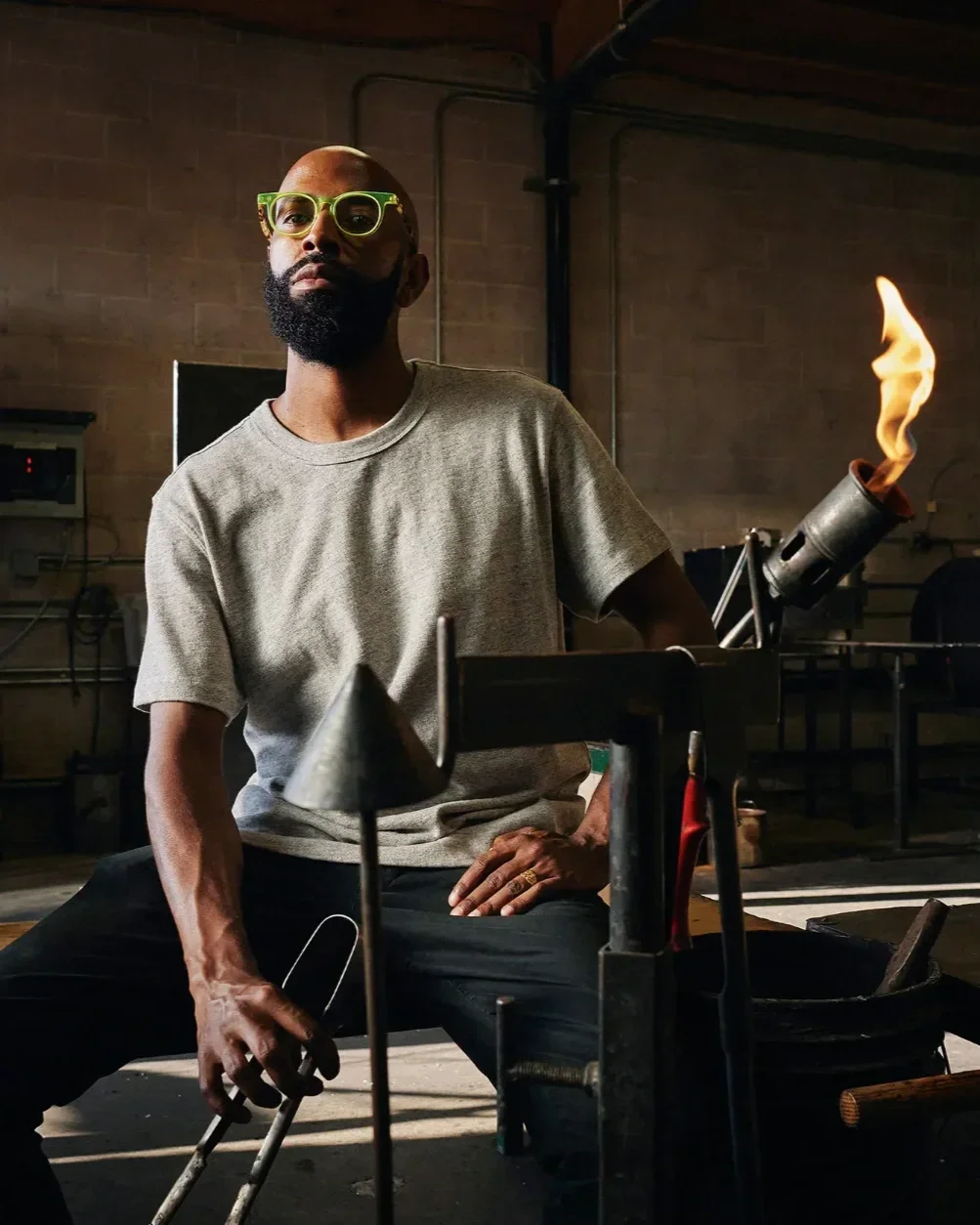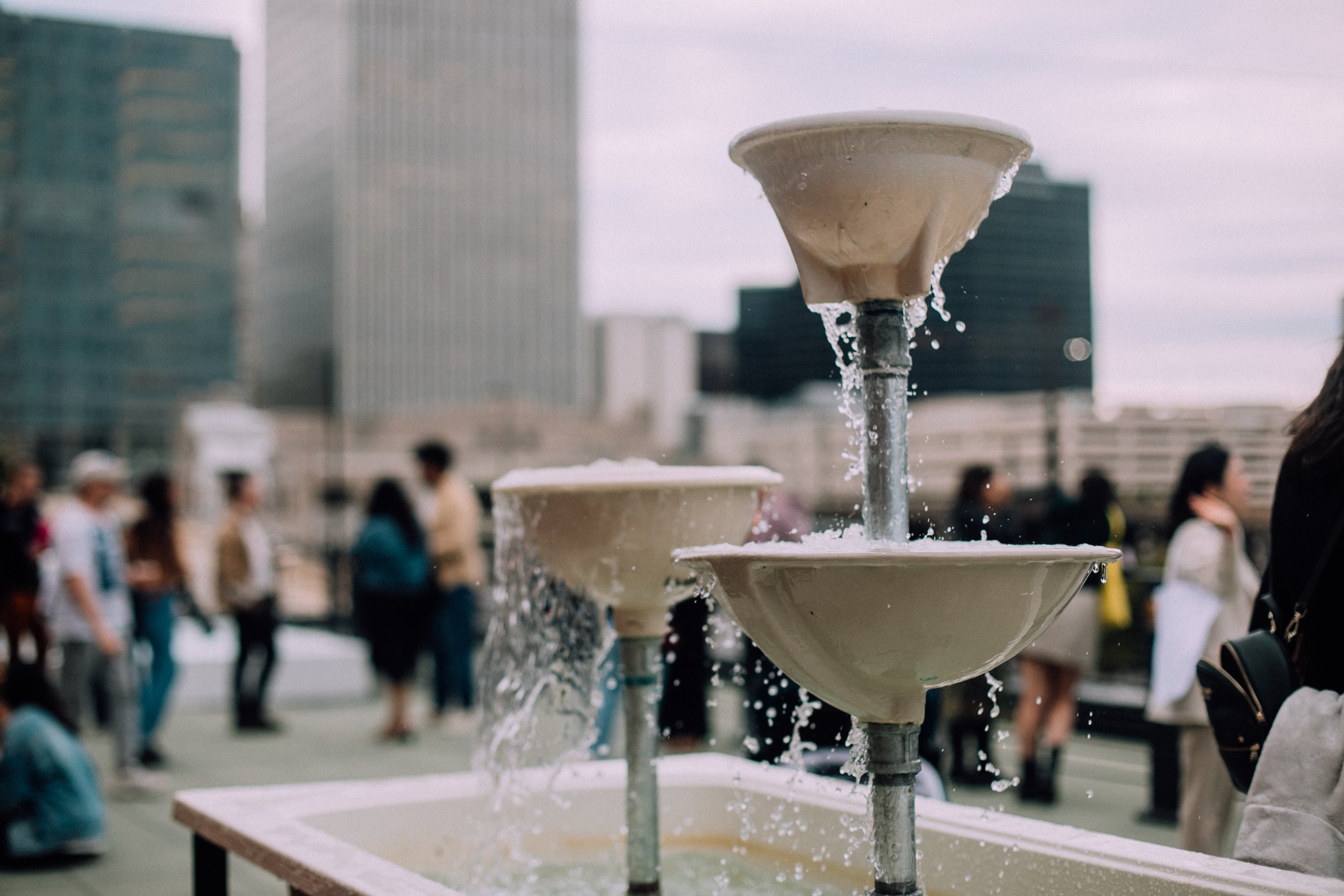Tulsa Artist Fellowship is pleased to present Le’Andra LeSeur: Monument Eternal, an evolving meditation on the violence of erasure, the weight of silence, and the profound effects these things have on collective identity and mental well-being, on view from October 3, 2025, through January 10, 2026, at Tulsa Artist Fellowship Flagship gallery.
What began as a personal reckoning with Stone Mountain, Georgia—the site of the Ku Klux Klan’s 1915 resurgence—has expanded into a broader, interconnected investigation into American landscapes where racial terror has taken root and where its memory remains unmarked or distorted. Through video, sculpture, photography, and sound, the project builds an embodied archive of presence where absence has long prevailed.
Monument Eternal centers on a titular video inspired by Stone Mountain—a public park distinguished by a three-acre-wide carving that depicts Confederate leaders on horseback, begun in 1923 and completed in 1972. In spite of this, it remains the state’s most popular attraction, frequented by local residents and tourists alike for its recreational offerings, and where LeSeur, who spent the majority of her adolescence in Atlanta, recalls many family gatherings. She began to consider its corporeal impact after revisiting the site as an adult, an experience that eventually gave way to this series.
A poetic translation of the body in collapse, the video stitches together slow-motion captures of the artist falling, unabated and repeatedly, on the mountain’s peak. The work borrows its title from an abridged autobiography written by Alice Coltrane, in which the avant-garde composer recounts her journey through physical and mental tests continuously self-imposed in the pursuit of spiritual transcendence. Similarly, LeSeur pushes her body to extreme physical limits within her own performance practice as a way of confronting and transcending both historical legacies of Blackness as well as her own personal identity as a queer Black person. This process of perseverance and self-discovery is captured within the spoken word poetry written and narrated by LeSeur, which provides the basis for the film’s score.
“My work aims for a more intentional and sensitive connection to, participation with, and activation of, sites of violence, sparking continuous dialogue around the impact these sites have had on Black communities. This work is communal, historical, social, political, and environmental. It is, for me, health care. At the core of this project, I introduce new forms of healing and reconciliation within the midst of trauma and violence, through repeated gestures and the transformation of sound into a physical presence. My practice continuously considers ways in which art can transform violence into something beyond. Monument Eternal transforms memories of violence, remnants of violence, and even physical embodiments of violence into transcendences.”
These themes continue in the most recent iteration of Monument Eternal, which shifts focus to the 1911 lynching of Laura Nelson and her son, LD Nelson, in Okemah, Oklahoma. Though this event predates the Klan’s resurgence at Stone Mountain, it forms part of the same lineage of racial violence. Here, LeSeur’s attention turns to how history is recorded or, more often, how it is suppressed. With no official marker on the site of Laura and LD’s lynching, what remains is an online image: gruesome, persistent, and dehumanizing. Through five new sculptural and photographic works, LeSeur resists the spectacle of this violence by creating alternative memorials where quietude and refusal are intentional. It echoes decades of avoidance, of stories unspoken and histories untaught.
Accompanying these installations are other works born from LeSeur’s visits to Stone Mountain, where she tracked involuntary movements—flicks of the wrist, shifts in breath—and translated them into mark-making gestures. These gestures reappear in paintings, drawings, and blown glass, transforming imperceptible responses into material evidence. In doing so, LeSeur continues her inquiry into how bodies carry history—and how art can become a vessel for healing.
The third iteration of Monument Eternal is commissioned, in part, by Tulsa Artist Fellowship. The touring works were co-commissioned by Pioneer Works and the Pittsburgh Cultural Trust, and are curated by Vivian Chui. This exhibition is made possible through the generous support of Tulsa Artist Fellowship; public funds from the New York City Department of Cultural Affairs in partnership with the City Council; and the New York State Council on the Arts, with the support of the Office of the Governor and the New York State Legislature.
EXHIBITION PROGRAMS
NOVEMBER 22 + 23, 2025 | VARIOUS LOCATIONS
On Death, Grief, and the Importance of the Archive:
Community Deathwork Educational | Two-Session Workshop | Free RSVP
Listen, Dance, Breathe | Single Class | Free RSVP
Language and the Altar | Single Class | Free RSVP
Le’Andra LeSeur brings together death doulas Resham Mantri and Trishia Frulla to lead a two-day program, On Death, Grief, and the Importance of the Archive, examining the enduring effects of grief. Together, they will explore how grief is embodied and carried through collective memory. They will also highlight the role of the personal archive as a vital act of care that disrupts cycles of violence and systemic erasure.
OCTOBER 4, 2025 | THE OATH STUDIO | CLOSED
It’s About You: Silence, Erasure, and the Persistence of Memory with Joël Díaz, Le’Andra LeSeur, and Jessica Lynne
On the occasion of Le’Andra LeSeur: Monument Eternal, this panel will consider how artistic practices anchored in language can reframe historical absences as sites of knowledge production and cultural continuity in the face of systemic erasure.
ABOUT THE ARTIST
Le’Andra LeSeur (b. 1989 in Bronx, NY) is a multidisciplinary artist whose work encompasses a range of media, including video, installation, photography, painting, and performance. Her body of work, a celebration of Blackness, queerness, and femininity, seeks to dismantle systems of power and achieve transcendence and liberation through perseverance. Through the insertion of her body and voice into her work, LeSeur provides her audience with an opportunity to contemplate themes such as identity, family, Black grief and joy, the experience of invisibility, and what it means to take up space as a queer Black woman—a rejection of the stereotypes which attempt to push these identities to the margins. The artist has received several notable awards, including the Tulsa Artist Fellowship (2024-2026), Leslie-Lohman Museum Artists Fellowship (2019), the Time-Based Medium Prize, and the Juried Grand Prize at Artprize 10 (2018). LeSeur has appeared in conversation with Marilyn Minter at the Brooklyn Museum, presented by the Tory Burch Foundation, and has lectured at The New School, NY, NY, and the University of the Arts, Philadelphia, PA, among others. Her work has been shown in solo and group exhibitions at MFA Boston, Boston, MA; Swivel Gallery, NY, NY; The Shed, New York, NY; Marlborough, New York, NY; Atlanta Contemporary, Atlanta, GA; A.I.R. Gallery, Brooklyn, NY; Assembly Room, New York, NY; Microscope Gallery, Brooklyn, NY; Arnika Dawkins, Atlanta, GA; and others. Residencies include Pioneer Works, iLab at The University of the Arts, Visual Studies Workshop, ArcAthens, NARS Foundation, Marble House Project, and MASS MoCA.
Le’Andra LeSeur, courtesy of Tulsa Artist Fellowship
AT THE STUDIOS
Courtesy of Cedric Mitchell and the Tacoma Museum of Glass
OCTOBER 3, 2025 - JANUARY 10, 2026 | STUDIOS
Cedric Mitchell: Funky Forms
During a residency at the Tacoma Museum of Glass, Los Angeles-based artist Cedric Mitchell, from Tulsa, created Funky Forms, a series that expands his signature Modern Funk aesthetic into new territory. Instead of working toward crisp, symmetrical silhouettes, Mitchell let the molten glass guide him—embracing swaying stems, uneven contours, and improvisational rhythms. Each vessel is punctuated with bold, dot-like marks that echo graffiti’s graphic energy. These layered motifs create shadows and depth, infusing the playful colors with a raw, urban edge. The results feel at once sculptural and performative: vibrant forms that embody the spirit of jazz riffs, freestyle lines, and spontaneous movement.
Cedric Mitchell is a Los Angeles-based glass artist from Tulsa, Oklahoma. Inspired by an eccentric mix of graffiti art, pop culture, and postmodernism, he creates work that ranges from functional to decorative art, combining simplicity with bold colors to craft hand-blown vessels with a purpose. Mitchell has completed residencies at the Corning Museum of Glass, the Penland School of Craft, and the Pilchuck Glass School. He developed Cedric Mitchell Design in 2018, where he creates blown glass for collections and retailers nationwide.
Cedric Mitchell, courtesy of Cedric Mitchell Design
LOCATIONS & HOURS
FLAGSHIP
112 North Boston Avenue
Tulsa, OK 74103
Fall/Winter Exhibition Season:
October 3, 2025 – January 10, 2026
Thursday – Saturday | 12:00 PM – 6:00 PM
First Fridays | 6:00 PM – 9:00 PM
Closed: December 25 & January 1
STUDIOS
109 Martin Luther King Jr. Boulevard
Tulsa, OK 74103
Closed: First Friday, January 2
To schedule a tour, please email info@tulsaartistfellowship.org.
VISITOR EXPERIENCE
Tulsa Artist Fellowship is committed to creating a welcoming, inclusive, and accessible environment for all. Our exhibitions and events are always free and open to the public. Programming is regularly documented and archived to ensure broader access.
Accessibility
Flagship and the Studios are wheelchair- and stroller-accessible. An elevator is available at the Studios to support access to all visitor areas. Variable seating is provided throughout both locations, along with designated spaces for distanced standing and wheelchair users. Family-style private restrooms are available to accommodate visitors with disabilities, caregivers, and anyone needing additional space or access to changing tables.
Parking
Street-side parking is available via the Park Mobile App. Parking is free after 5:00 PM on weekdays and all day on weekends (Saturday–Sunday).
ABOUT FLAGSHIP
Opened in 2022, Flagship is Tulsa Artist Fellowship’s public project space located in the heart of Tulsa’s historic downtown. Spanning 2,421 square feet, Flagship was purposefully designed as a flexible, artist-centered venue for community connection and creative exchange. Programming ranges widely—exhibitions, performances, literary readings, sound installations, screenings, artist talks, interviews, roundtables, panel discussions, workshops, symposiums, and more—reflecting a commitment to experimentation, dialogue, and public engagement.














